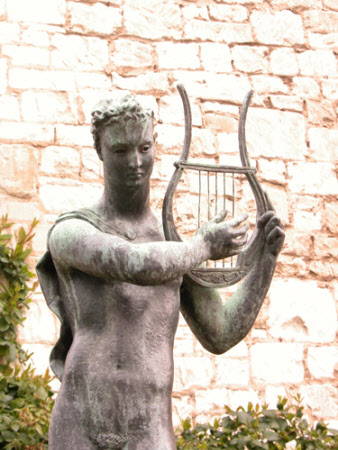Orpheus
Stephen Leslie Rickard (Carshalton 1917-Newark-on-Trent 2014)
Category
Art / Sculpture
Date
1948
Materials
Bronze
Measurements
1140 x 370 x 230 mm
Place of origin
London
Order this imageCollection
Anglesey Abbey, Cambridgeshire
NT 515119
Summary
Bronze, Orpheus, Leslie Stephen Rickard (1917-2014), 1948. A bronze statue of the ancient Greek poet Orpheus, made by Leslie Stephen Rickard in 1948. Orpheus is shown standing, his foot supported against a piece of stylised scrolling vegetation. He is naked except for a short piece of drapery over his right shoulder, which falls down his back. He holds in his raised left hand a five-stringed lyre, which he plucks with the fingers of his right hand. The statue is placed on a Swedish cast-iron flower vase with scenes of the life of Apollo and the worship of the Sun, on a stone mounting block.
Full description
Orpheus was a legendary Greek poet and musician from Thrace in Northern Greece, regarded by the Greeks as the most celebrated poet before Homer. The sun god Apollo presented Orpheus with a lyre, which he was taught to play by Apollo’s followers the Muses. Orpheus became so proficient on the instrument that he was able through the beauty of the music he made to charm not only the wild beasts, but also the trees and rocks, which would all gather round and follow him whenever he played. Orpheus’s story was ultimately a tragic one. Having accompanied the Argonauts on their expedition, he returned to Thrace, where he married the wood nymph Euridice. One day Euridice, trying to escape the unwelcome attentions of a suitor, trod on and was fatally bitten by a snake; as she died she descended into the underworld, Hades, ruled over by the god Pluto. Orpheus used the power of his music to persuade Pluto to allow Euridice to follow her husband out of the depths, but only on condition that he did not turn to look at her until they had reached the upper world again. At the very last moment Orpheus could not resist the temptation and, as he turned to glance at his beloved, Euridice vanished back into Hades. Orpheus’s devastating grief caused him to come to despise women, because of which he was attacked and torn to pieces by frenzied Maenads, wild followers of Bacchus. Orpheus has subsequently come to be seen as a symbol of music and its power to stir and move emotions. Stephen Rickard’s statue shows him playing his lyre, perhaps as he leads Euridice from Hades or perhaps, and appropriately given the sculpture’s position in the gardens of Anglesey Abbey, enchanting animals, trees and even the rocks with his music. Stephen Rickard was a sculptor, glass-engraver and, in his latter years, wood turner. He exhibited sculptures at the Royal Academy Summer Exhibitions periodically between 1940 and 1965, including portraits and larger-scale figures, the subject matter often taken from ancient Greek or Roman mythology. For example, in 1940 he showed a statuette of Daphnis and Chloe (no. 1625) and in 1953 a second treatment of the same theme (no. 1208). The plaster model of Rickard’s Orpheus was exhibited at the Summer Exhibition in 1948, Lord Fairhaven buying the piece and commissioning Rickard to cast the model in bronze. A few years later in 1952, Lord Fairhaven would commission Stephen Rickard to sculpt his portrait in bronze (NT 515051). The cast-iron vase in which the statue is today placed is not part of Stephen Rickard’s design; its decoration with scenes from the life of Apollo contributed to misidentification of Rickard’s statue as the god of the Sun. Jeremy Warren 2019
Provenance
Bequeathed to the National Trust by Huttleston Rogers Broughton, 1st Lord Fairhaven (1896-1966) with the house and the rest of the contents.
Credit line
Anglesey Abbey, The Fairhaven Collection (The National Trust)
Makers and roles
Stephen Leslie Rickard (Carshalton 1917-Newark-on-Trent 2014), sculptor
References
Christie, Manson & Woods 1971: The National Trust, Anglesey Abbey, Cambridge. Inventory: Furniture, Textiles, Porcelain, Bronzes, Sculpture and Garden Ornaments’, 1971, p. 157. The exhibition of the Royal Academy, 1948. The 180th., London 1948, p. 64, no. 1329. Roper 1964: Lanning Roper, The Gardens of Anglesey Abbey, Cambridgeshire. The Home of Lord Fairhaven, London 1964, p. 62, Pl. 34.

